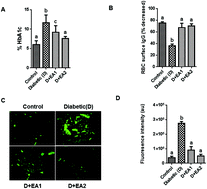Ellagic acid inhibits non-enzymatic glycation and prevents proteinuria in diabetic rats
Abstract
The formation of advanced glycation end products (AGEs) is a characteristic feature of diabetic tissues and accumulation of these products has been implicated in the pathogenesis of micro- and macrovascular complications of diabetes including diabetic nephropathy (DN). Compelling evidence suggests that AGEs mediate progressive alteration in the renal architecture and loss of renal function whereas inhibitors of AGEs prevent the progression of experimental DN. We have investigated the potential of ellagic acid (EA), a polyphenol present abundantly in fruits and vegetables, to prevent in vivo accumulation of AGE and to ameliorate renal changes in diabetic rats. Streptozotocin-induced diabetic rats were fed with either 0.2% or 2% of EA in the diet for 12 weeks. Dietary supplementation of EA to diabetic rats prevented the glycation mediated RBC-IgG-cross-links and HbA1c accumulation. EA inhibited the accumulation of N-carboxymethyl lysine (CML), a predominant AGE in the diabetic kidney. Further, EA also prevented the AGE-mediated loss of expression of podocyte slit diaphragm proteins: nephrin and podocin. By inhibiting CML formation, EA improved renal function in rats as evidenced by urinary albumin and creatinine levels. In conclusion, EA inhibited AGE accumulation in the diabetic rat kidney and ameliorated AGE-mediated pathogenesis of DN.


 Please wait while we load your content...
Please wait while we load your content...